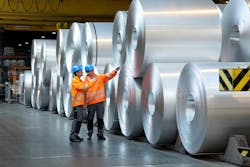Aluminum Industry says Energy Efficiencies drove Carbon Footprint down 49% since 1991
The aluminum production industry is touting a new report which indicates it has cut carbon emissions dramatically over the past three decades.
The third-party report, The Environmental Footprint of Semi-Fabricated Aluminum Products in North America life cycle assessment (LCA) report, has shown a 49% decline in the carbon footprint of primary aluminum production and a 60% decline in the footprint of recycled aluminum production since 1991.
The report also noted a 27% decline in energy needed to produce primary aluminum and a 49% decline in energy required for recycled aluminum production.
The carbon footprint of aluminum production between 2010 and 2016 declined by 5% to 21%. The report was led by the Aluminum Association in cooperation with Chicago-based sustaintability consultant Sphera.
Charles Johnson, president & CEO of the Aluminum Association said, “The U.S. aluminum industry continues to innovate and find ways to produce this essential metal in as environmentally sustainable way as possible. And we’re nowhere close to done – every day, our members pursue new approaches to make this lightweight, durable and infinitely recyclable material using less energy and with lower emissions.”
The LCA report explains that primary and recycled aluminum production is the single-largest element of the industry’s environmental impact for product manufacturing. In recent years, technological advancements, including manufacturing process controls; efficiency improvements, phasing out of old smelting technologies and the replacement of coal-fired smelting to the use of renewable electricity in the smelting process have contributed to an improvement in the production process.
Related stories
EIA: U.S. C&I Energy Emissions work account for nearly half of Nation's falling C02 Emissions
Wendy's Restaurants largest franchise owner to deploy Smart Building Technologies
Subscribe to Energy's Tech free, tri-weekly ENL for more stories on the C&I Energy Transition
Regional variation in production also impact the environment footprint of the aluminum products. For instance, making products, like aluminum sheet, die cast aluminum and aluminum foil, in regions like the Middle East or China, which rely mainly on coal and natural-gas-based electricity, can make the process two to three times more carbon intensive than when produced in North America.=
Moreover, the report notes that aluminum recycling can help make the industry more sustainable. Making recycled aluminum is 94% less carbon intensive than making primary aluminum. A 1% increase in aluminum recycling rate can reduce the product carbon footprint by 80 kg of CO2 equivalent per 1,000 kg of aluminum produced. However, over a million tons of aluminum ends up in landfills each year.
The Aluminum Association is focused on increasing aluminum recycling rates, by advocating for new investment in recycling infrastructure and policy changes to incentivize the collection of used aluminum.
About the Author
EnergyTech Staff
Rod Walton is head of content for EnergyTech.com. He has spent 17 years covering the energy industry as a newspaper and trade journalist.
Walton formerly was energy writer and business editor at the Tulsa World. Later, he spent six years covering the electricity power sector for Pennwell and Clarion Events. He joined Endeavor and EnergyTech in November 2021.
He can be reached at [email protected].
EnergyTech is focused on the mission critical and large-scale energy users and their sustainability and resiliency goals. These include the commercial and industrial sectors, as well as the military, universities, data centers and microgrids.
Many large-scale energy users such as Fortune 500 companies, and mission-critical users such as military bases, universities, healthcare facilities, public safety and data centers, shifting their energy priorities to reach net-zero carbon goals within the coming decades. These include plans for renewable energy power purchase agreements, but also on-site resiliency projects such as microgrids, combined heat and power, rooftop solar, energy storage, digitalization and building efficiency upgrades.
